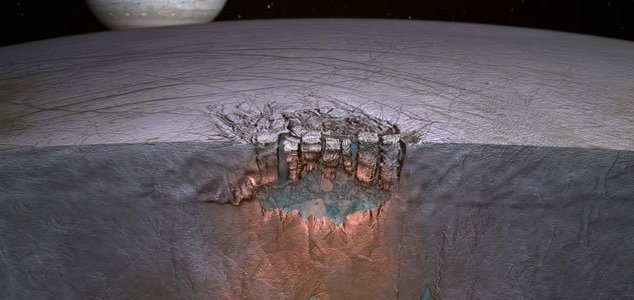Space & Astronomy
December 13, 2013 · 16 comments
16 comments

Could there be life on Europa ? Image Credit: Britney Schmidt/Dead Pixel VFX
Computer models seemed to suggest that the spikes could be caused by huge plumes of water vapor gushing up from the liquid ocean deep below Europa's thick icy crust. The anomalies seemed to occur at the point furthest from Jupiter suggesting that they may be a direct result of the planet's gravity which can exert forces up to 1,000 times greater than those our moon exerts on the Earth.
If the spikes do turn out to be geysers then not only would they be enormous but they could also provide a unique opportunity for a future spacecraft to sample the water that exists within Europa's ocean without having to rely on melting its way down through the ice to access the ocean directly.
Source: Space.com | Comments (16)
Europa could be home to 200km high geysers
By T.K. RandallDecember 13, 2013 ·
 16 comments
16 comments
Could there be life on Europa ? Image Credit: Britney Schmidt/Dead Pixel VFX
Geysers on Jupiter's icy moon Europa may reach heights 20 times greater than that of Mount Everest.
The possibility was identified by researchers who had been examining ultraviolet images of Europa taken by the Hubble Space Telescope in an attempt to seek out the elements that make up water - oxygen and hydrogen. What they found was a series of spikes in the levels of these elements across two specific regions of Europa's southern hemisphere.If the spikes do turn out to be geysers then not only would they be enormous but they could also provide a unique opportunity for a future spacecraft to sample the water that exists within Europa's ocean without having to rely on melting its way down through the ice to access the ocean directly.
Source: Space.com | Comments (16)

The Unexplained Mysteries
Book of Weird News
AVAILABLE NOW
Take a walk on the weird side with this compilation of some of the weirdest stories ever to grace the pages of a newspaper.
Click here to learn more

Support us on Patreon
BONUS CONTENTFor less than the cost of a cup of coffee, you can gain access to a wide range of exclusive perks including our popular 'Lost Ghost Stories' series.
Click here to learn more
Ancient Mysteries and Alternative History
Unexplained TV, Books, Film and Radio
UK and Europe
Ghosts, Hauntings and The Paranormal
Total Posts: 7,779,937 Topics: 325,660 Members: 203,950
Not a member yet ? Click here to join - registration is free and only takes a moment!
Not a member yet ? Click here to join - registration is free and only takes a moment!


































Please Login or Register to post a comment.